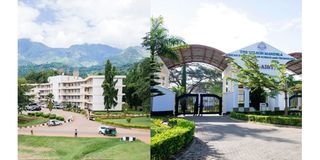Seven factors behind Tanzania’s clean cities and universities

What you need to know:
- Leading universities attributed their success to prioritising cleanliness, engaging professional cleaning services, establishing robust waste disposal systems and innovative waste-to-energy initiatives
Dar es Salaam. Seven major factors have been identified as reasons why some Tanzanian colleges and cities ranked first in the recently released national health and environmental cleanliness rankings.
The main drivers of university success were identified as prioritising cleanliness, signing contracts with professional cleaning companies, establishing waste disposal infrastructure, and converting waste into alternative energy sources.
For city councils, major contributing factors included the availability of designated landfills for waste disposal, collaboration between local leaders and citizens, outsourcing waste collection to private companies, and installing waste bins in highly populated areas.
These revelations were made by leaders of the winning institutions and municipalities, following the recent announcement by the ministry of Health of the national winners of the 2025 Health and Environmental Cleanliness Competition over the weekend.
Among the 19 universities assessed, the Nelson Mandela African Institution of Science and Technology (NM-AIST) in Arusha scored the highest, 93.3 percent.
It was followed by Sokoine University of Agriculture (SUA), which garnered 89.6 percent. Catholic University of Health and Allied Sciences (CUHAS) came third with a score of 84.5 percent, followed by St Augustine University of Tanzania in Mwanza at 71.5 percent, and the University of Dar es Salaam (UDSM), located in Ubungo Municipality, at 70.5 percent.
For cities, Tanga City Council emerged as the winner among the six cities assessed, with a score of 83.2 percent.
Mbeya City came second with 81.5 percent, and Arusha City followed closely with 80.0 percent. Cities that scored lowest included Mwanza (79.2 percent), Dar es Salaam (71.2 percent), and Dodoma (70.8 percent).
The key criteria used in the evaluation included management of solid waste, access to safe and clean water, control of wastewater, proper toilet usage, cleanliness of markets, abattoirs, primary and secondary schools, municipal hospitals, banks, and the general aesthetic of streets and burial grounds.
NM-AIST Health Officer Achiwa Sapuli said their win was well-deserved, given the efforts the university has made to maintain a clean and healthy environment.
“First, we have a dedicated cleaning company under contract. Secondly, the university leadership is highly involved in monitoring cleanliness,” he said. “We maintain hygiene from student dormitories to toilets, administrative offices and the gardens, which are managed by a dedicated team.
“He added that NM-AIST has constructed proper drainage for wastewater, which is collected and recycled.
Additionally, all waste on campus is used to produce biogas or collected weekly by the contracted waste management firm. The institution also has specialised facilities to handle hazardous waste.
According to Mr Sapuli, this is not the first time NM-AIST has ranked first in the national competition. It also won in 2022 and placed third in 2023.
Acting Head of the Communications and Marketing Unit at SUA, Suzana Magobeko, attributed their success to strong leadership collaboration and placing cleanliness high on their agenda.
“We work closely with a cleaning company and treat sanitation as a health priority for both students and staff.
This win motivates us to keep improving our environment,” she said.
She added that criteria considered included the surrounding areas of the institution, availability of structured sanitation plans, access to quality toilets, handwashing facilities and overall hygiene levels.
Tanga City director Juma Hamsini attributed the city’s top ranking to effective cooperation between political leaders, city officials and private stakeholders involved in waste collection.
“We have community members who send photos of littered areas to officials, and prompt action is taken,” he explained.
He also noted that modern waste collection vehicles had been acquired and that waste bins were strategically placed in areas that generate large volumes of refuse.
Furthermore, hospitals and health centres in Tanga separate medical waste and dispose of it in designated areas.
In Mbeya, City Director John Nchimbi said their progress came from encouraging broad participation in keeping the city clean.
“In previous years, we ranked last due to a lack of sufficient waste collection vehicles,” he said.
“We have since signed a contract with SUMA JKT, a waste management company that brought in enough vehicles to improve cleanliness significantly.
” According to Mr Nchimbi, outsourcing to SUMA JKT reduced operational costs and increased professionalism in waste collection.
He also highlighted the construction of a landfill capable of handling up to 300,000 tonnes of waste per week, which has helped eliminate long queues for waste disposal.
“We’ve also decentralised cleanliness responsibilities to the ward level.
Police officers and ward leaders educate citizens on hygiene.
Sometimes we inspect household toilets to ensure standards are met,” he said.
In addition, he said groups involved in waste management have been linked with the council’s loan scheme, and new garbage trucks from China are on the way to enhance their capacity.
On the other hand, Prof Bernadetha Kilian from the University of Dar es Salaam emphasised that UDSM’s efforts are deeply rooted in sustainability.
“As a historic institution with a vital role in national development, we focus on preserving the environment to improve both teaching and learning conditions,” she said.
“We work with various cleaning companies and educate students on the sustainable use of infrastructure and the campus environment.
We also utilise our in-house experts from the Botany Department, the Centre for Climate Change, and the Directorate of Estates to guide our environmental initiatives.”





